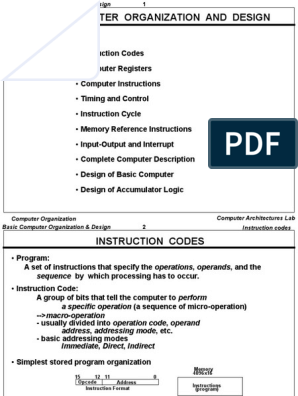0% found this document useful (0 votes)
20 views18 pagesComputer Organization Part 1
The document outlines the fundamentals of computer instruction codes, detailing how programs are executed through a sequence of instructions stored in memory. It explains the structure of instruction codes, addressing modes, and the roles of various computer registers in processing instructions. Additionally, it covers the timing and control mechanisms for instruction cycles and the organization of control units in a basic computer architecture.
Uploaded by
HolyGraceCopyright
© © All Rights Reserved
We take content rights seriously. If you suspect this is your content, claim it here.
Available Formats
Download as PDF, TXT or read online on Scribd
0% found this document useful (0 votes)
20 views18 pagesComputer Organization Part 1
The document outlines the fundamentals of computer instruction codes, detailing how programs are executed through a sequence of instructions stored in memory. It explains the structure of instruction codes, addressing modes, and the roles of various computer registers in processing instructions. Additionally, it covers the timing and control mechanisms for instruction cycles and the organization of control units in a basic computer architecture.
Uploaded by
HolyGraceCopyright
© © All Rights Reserved
We take content rights seriously. If you suspect this is your content, claim it here.
Available Formats
Download as PDF, TXT or read online on Scribd
/ 18






















































































